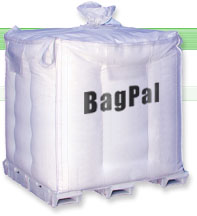Wikipedia describes ISPM 15 as the:
"International Phytosanitary Measure developed by the IPPC that directly addresses the need to treat wood materials of a thickness greater than 6mm, used to ship products between countries. It affects all wood packaging material (pallets, crates, dunnage, etc) requiring that they be treated with heat or fumigated with methyl bromide and marked, often branded, with a seal of compliance. "
Wood Pallet Cost Rising
As a result, the total cost of wood pallet usage has escalated dramatically. Not only has the cost of ISPM 15 compliant pallets increased, shipping documentation preparation and possible border crossing delays consume additional time and resources.
That coupled with historic problems related to mold growth, damage to shipped product from pallet defects (splinters, nails, etc.) and the outright refusal of some countries and/or customers to accept wood pallets has caused a strong desire to find a wood pallet alternative.
Bulk Bag Solution
If you ship your product in bulk bags there are two solutions that Control and Metering can recommend:
- Plastic pallet replacement channels.
- Shipping bulk bags without any kind of pallet-like support.
Plastic Pallet Replacement Channels
We have had extensive experience with BagPal channels. These are designed to slip into sleeves attached to the bottom of specially made bulk bags allowing the bulk bag to be handled by a forklift just like a bulk bag on a wooden pallet.
BagPal channels are robust, compare favorably price-wise with treated wood pallets and can be reused and recycled.
Also, they provide a traditional means of moving bulk bags with a forklift - any forklift with standard tines can be used to move a BagPal equipped bulk bag.
Plus, a pair of BagPal channels weighs less and is much smaller than a wood pallet. These features provide two significant financial benefits:
- Reduce shipping costs by increasing your bulk bag payload by the difference in weight between a pallet and the channels - roughly 30+ lb. Higher payload per bag equals more product in a truck or container.
- Increase warehouse efficiency by using MUCH less space to store empty channels vs. empty pallets.
Bulk Bags Minus Bottom Support
Bulk bags can be shipped without bottom handling support of any kind. This has been done in a number of industries for both domestic and export delivery to customers.
Without bottom handling support bulk bags must be lifted using their loops. Preventing damage and contamination of the bag bottom is also required.
Specially designed bulk bags with unique lifting loops and protective bottom panel barriers solve these issues.
Shipping bulk bags without bottom handling support is a topic by itself and will be the topic of next week's blog post.


